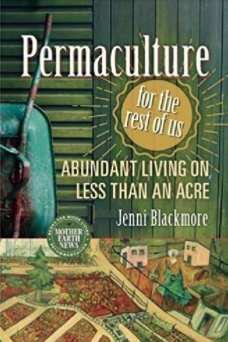The Big Idea: With creativity and persistence, you can live well on a small homestead, even if the climate is difficult and the soil is subpar.
- Every homestead will be unique. Contours, zones and sectors should be mapped out on paper before getting started.
- Zones are concentric circles around your home. Zone 0 is your home. Zone 1 is next out and will contain herbs, etc. Zone 5 is further away and will contain less visited trees and bushes.
- Sectors are like slices of a pie-chart that clearly define sunniest spots, wind tunnels, water courses, etc.
- Develop the land slowly so that you have time to experiment, adjust, and enjoy.
- Develop intimate knowledge of every corner of your land.
- Encourage what wants to stay and let the rest go away. This will lighten your work immensely.
- Soil is made of sand, silt, and clay. There is an ideal ratio of all three for plants.
- Important layers are: topsoil (2-8″), subsoil (12-30″), and bedrock.
- Only a few plants (comfrey, dandelions, daikon radish) have roots long enough to penetrate subsoil and bring nutrients up.
- Amend soil by adding good organic material like compost, humus, and worms.
- A well-designed compost bin can speedy up decomposition and keep things clean.
- Red Wrigglers are the best compost worm.
- Chickens can be a great help turning compost.
- Chicken manure must be aged one year before using on plants.
- Comfrey fixes nitrogen, attracts bees, can reach down into the subsoil, and can be used to supplement compost piles or as green mulch. Just be careful to plant comfrey in an unused area of land.
- Digging and tilling disrupts the organisms living in good soil. Try the no-till method instead.
- Instead of digging vegetable garden beds, use raised bed gardens.
- Try hugelkultur raised bed gardens.
- Try keyhole raised bed gardens.
- Try lasagna raised bed gardens.
- Copper mesh along the top sides of raised bed walls keeps slugs away.
- An herb spiral is a classic permaculture design.
- Every vegetable has its own growing preference. Proper timing and environment is essential to learn.
- Easy starter crops: garlic, chard, potatoes, squash.
- Crop rotation is essential to healthy gardens.
- Get at least on really comprehensive gardening guide to explain each plant’s preferences.
- Legumes are great for the soil.
- Greenhouses are not a luxury. They are integral to a successful homestead.
- You can find lots of inexpensive DIY designs online.
- Traditionally, greenhouses are placed with maximum southern exposure but this is not a hard rule.
- Three purposes of a greenhouse: starting seeds, growing plants that prefer warmth, prolonging seasonal growth. If you’re a gardening enthusiast looking to extend your growing season, consider buying a greenhouse.
- Brussel sprouts are underrated vegetables and should be started inside.
- Ladybugs are fantastic for dealing with an aphid problem.
- Even the smallest homestead should have a wild Zone 5. (Zone 4 is a food forest. Zones 2 and 3 are gardens, compost, and animals.
- Hugulkulture is ideal in colder climates because it creates a warmer environment for growing.
- Natural or manmade microclimates help protect plants from wind and cold.
- While not required, good livestock design makes permaculture easier.
- Chickens are great for eggs, manure, composting scraps.
- Chicken manure always needs to be aged before using.
- Chickens need to be well-protected from predators
- Ducks are great for eggs and slug control.
- Ducks are harder to keep because of their water requirements. Minimum 4 inches of water to dunk their heads.
- Rabbits are great for meat production.
- Rabbit manure can be used immediately in gardens.
- Turkeys are good for meat and eggs and very easy to care for.
- Build a chicken tractor and a henposter if you raise chickens.
- Principle 1: Feedback loops: accepting and responding to change.
- Principle 2: Integrated symbiotic support between all systems: every system must support other systems and in turn be supported by other systems.
- Principle 3: Cultivate local species: avoid introducing invasive species.
- Principle 4: Ensure the fair distribution of yield and empower others to become self-sustaining.
- Principle 5: Continuous and mindful observation.
- Principle 6: Intelligent design and the observation of naturally occurring patterns.
- Principle 7: Capturing and storing energy and the efficient use of resources.
- Principle 8: Ensure a yield.
- Principle 9: Start small and move slowly.
- Principle 10: Introduce renewable, biological resources only.
- Principle 11: Celebrate and value diversity.
- Principle 12: See creative solutions not problems.
- Save any valuable seeds in labeled pill bottles or envelopes.
- Learn to preserve harvest with canning, drying, root cellars, cold rooms, freezing.
- Cold frames and greenhouses help to prolong the growing season.
- Read Mycelium Running by Paul Stamets.
